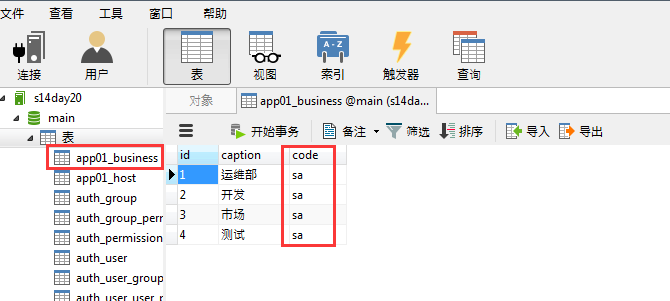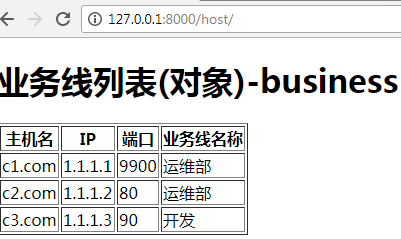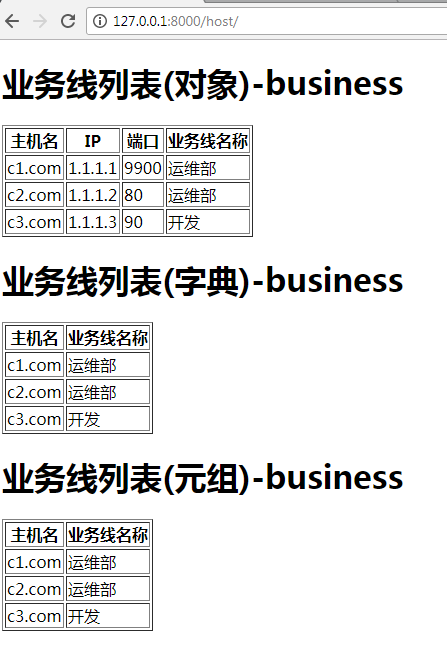Day20-单表中获取表单数据的3种方式
1. 搭建环境请参考:http://www.cnblogs.com/momo8238/p/7508677.html
2. 创建表结构
models.py
from django.db import models
# Create your models here.
class Business(models.Model):
#id列,是自动创建的
caption=models.CharField(max_length=32)
class Host(models.Model):
nid=models.AutoField(primary_key=True)
hostname=models.CharField(max_length=32,db_index=True) #加上索引,可以提高查询速度
ip=models.GenericIPAddressField(protocol="ipv4",db_index=True)
port=models.IntegerField()
b=models.ForeignKey("Business",to_field='id')
在Terminal端执行:
python manage.py makemigrations python manage.py migrate
3. 在SQLite中打开.

4. 在business业务线数据表中,手动增加几条数据

5. 如果此时想再往 business表中增加一列的话,会报错。因为程序不知道该怎么给已经存在的数据赋这列值。code=models.CharField(max_length=32)
或者可以在新建的时候写上null=True; code=models.CharField(max_length=32,null=True)
或者可以在新建的时候写上default="sa"; code=models.CharField(max_length=32,default="sa")

选1,增加默认值"sa", 重新打开一下表,就可以看到更新了。


导入相应的模块,from app01 import models (这里的意思是导入models.py这个模块)

6.在business表中,测试在单表中获取数据的三种方式。QuerySet就像一个列表,只不过里面存放的是很多对象。
记忆:只要出现values,那么里面存放的就是字典;
只要出现values_list,那么里面存放的就是列表;
除此之外,其它的都是对象。
下面获取到的都是QuerySet对象。
v1 = models.Business.objects.all()
#QuerySet类型,里面存放的是对象。[obj(id,caption,code),obj,obj]
v2 = models.Business.objects.all().values('id','caption')
# QuerySet类型,里面存放的是字典[{'id':1,'caption':'运维部'},{'id':1,'caption':'开发部'}..]
v3 = models.Business.objects.all().values_list('id', 'caption')
# QuerySet类型,里面存放的是元组[(1,'运维部'),(2,'开发部').....]
如果想获取一个对象,可以用以下的方法。
models.Business.objects.get(id=1) #如果不存在的花,则会报错。
models.Business.objects.filter(id=1) #获取到的是一个对象列表,如果没有匹配的值,返回的列表就为空。但不会报错。
models.Business.objects.filter(id=1).first() #获取对象列表中的第一个值。

粘贴部分程序
urls.py
from django.conf.urls import url
from django.contrib import admin
from app01 import views
urlpatterns = [
url(r'^admin/', admin.site.urls),
url(r'^business/', views.business),
]
views.py
from django.shortcuts import render,HttpResponse
from app01 import models
# Create your views here.
def business(request):
v1 = models.Business.objects.all()
#QuerySet类型,里面存放的是对象。[obj(id,caption,code),obj,obj]
v2 = models.Business.objects.all().values('id','caption')
# QuerySet类型,里面存放的是字典[{'id':1,'caption':'运维部'},{'id':1,'caption':'开发部'}..]
v3 = models.Business.objects.all().values_list('id', 'caption')
# QuerySet类型,里面存放的是元组[(1,'运维部'),(2,'开发部').....]
return render(request,'business.html',{'v1':v1,'v2':v2,'v3':v3})
business.html
<!DOCTYPE html>
<html lang="en">
<head>
<meta charset="UTF-8">
<title>Title</title>
</head>
<body>
<h1>业务线列表(对象)-business</h1>
{% for row in v1 %}
<li>{{row.id}} - {{row.caption}} - {{row.code}}</li>
{% endfor %}
<h1>业务线列表(字典)-business</h1>
{% for row in v2 %}
<li>{{row.id}} - {{row.caption}}</li>
{% endfor %}
<h1>业务线列表(元组)-business</h1>
{% for row in v3 %}
<li>{{row.0}} - {{row.1}}</li>
{% endfor %}
</body>
</html>
models.py
from django.db import models
# Create your models here.
class Business(models.Model):
#id列,是自动创建的
caption=models.CharField(max_length=32)
code=models.CharField(max_length=32)
class Host(models.Model):
nid=models.AutoField(primary_key=True)
hostname=models.CharField(max_length=32,db_index=True) #加上索引,可以提高查询速度
ip=models.GenericIPAddressField(protocol="ipv4",db_index=True)
port=models.IntegerField()
b=models.ForeignKey("Business",to_field='id')
网页中的效果:

7. 手动在app01_host表中增加数据备用

8. 稍做测试,看下row.b_id, row_b 分别输出的是什么
row.b_id:是数字
row_b:是business object 对象

row:属于Host object对象
row.b:属于Business object 对象

既然row.b属于Business object 对象,那么它后面就可以再通过. 去获取它下面的属性和方法

插播一句:
所有的变量都是对象。 对象在python里,其实是一个指针,指向一个数据结构,数据结构里有属性,有方法。
9. 在前端输出所有信息
host.html中
<!DOCTYPE html>
<html lang="en">
<head>
<meta charset="UTF-8">
<title>Title</title>
</head>
<body>
<h1>业务线列表(对象)-business</h1>
<table border="1">
<thead>
<tr>
<th>主机ID</th>
<th>主机名</th>
<th>IP</th>
<th>端口</th>
<th>业务线ID</th>
<th>业务线名称</th>
<th>业务线编码</th>
</tr>
</thead>
<tbody>
{% for row in v1%}
<tr>
<td>{{row.nid}}</td>
<td>{{row.hostname}}</td>
<td>{{row.ip}}</td>
<td>{{row.port}}</td>
<td>{{row.b_id}}</td>
<td>{{row.b.caption}}</td>
<td>{{row.b.code}}</td>
</tr>
{% endfor %}
</tbody>
</table>
</body>
</html>
效果图:

优化输出,隐藏了主机ID和业务线ID
<!DOCTYPE html>
<html lang="en">
<head>
<meta charset="UTF-8">
<title>Title</title>
</head>
<body>
<h1>业务线列表(对象)-business</h1>
<table border="1">
<thead>
<tr>
<th>主机名</th>
<th>IP</th>
<th>端口</th>
<th>业务线名称</th>
</tr>
</thead>
<tbody>
{% for row in v1%}
<tr hid="{{row.nid}}" bid="{{row.b_id}}">
<td>{{row.hostname}}</td>
<td>{{row.ip}}</td>
<td>{{row.port}}</td>
<td>{{row.b.caption}}</td>
</tr>
{% endfor %}
</tbody>
</table>
</body>
</html>
效果图:

10. 一对多表操作,也就是跨表操作。通过.可以实现跨表,通过__也可以实现跨表操作,不过两者的使用场景不同。
from django.shortcuts import render,HttpResponse
from app01 import models
# Create your views here.
def business(request):
v1 = models.Business.objects.all()
#QuerySet类型,里面存放的是对象。[obj(id,caption,code),obj,obj]
v2 = models.Business.objects.all().values('id','caption')
# QuerySet类型,里面存放的是字典[{'id':1,'caption':'运维部'},{'id':1,'caption':'开发部'}..]
v3 = models.Business.objects.all().values_list('id', 'caption')
# QuerySet类型,里面存放的是元组[(1,'运维部'),(2,'开发部').....]
return render(request,'business.html',{'v1':v1,'v2':v2,'v3':v3})
def host(request):
v1=models.Host.objects.filter(nid__gt=0) #nid>0,其实代表的是所有数据
# for row in v1:
# print(row.b)
# print(row.b.caption,row.b.code,sep='\t')
# return HttpResponse("Host")
v2 = models.Host.objects.filter(nid__gt=0).values('nid','hostname','b_id','b__caption')
#QuerySet:[{}]
print(v2)
return render(request, 'host.html', {'v1': v1})

10.2

用字典的方法,让前端获取到数据

总结3种跨表方式
views.py
from django.shortcuts import render,HttpResponse
from app01 import models
# Create your views here.
def business(request):
v1 = models.Business.objects.all()
#QuerySet类型,里面存放的是对象。[obj(id,caption,code),obj,obj]
v2 = models.Business.objects.all().values('id','caption')
# QuerySet类型,里面存放的是字典[{'id':1,'caption':'运维部'},{'id':1,'caption':'开发部'}..]
v3 = models.Business.objects.all().values_list('id', 'caption')
# QuerySet类型,里面存放的是元组[(1,'运维部'),(2,'开发部').....]
return render(request,'business.html',{'v1':v1,'v2':v2,'v3':v3})
def host(request):
v1=models.Host.objects.filter(nid__gt=0) #nid>0,其实代表的是所有数据
# for row in v1:
# print(row.b)
# print(row.b.caption,row.b.code,sep='\t')
# return HttpResponse("Host")
v2 = models.Host.objects.filter(nid__gt=0).values('nid','hostname','b_id','b__caption')
#QuerySet:[{}]
for row in v2:
print(row['nid'],row['hostname'],row['b_id'],row['b__caption'])
v3 = models.Host.objects.filter(nid__gt=0).values_list('nid', 'hostname', 'b_id', 'b__caption')
return render(request, 'host.html', {'v1': v1,'v2':v2,'v3':v3})
host.html
<!DOCTYPE html>
<html lang="en">
<head>
<meta charset="UTF-8">
<title>Title</title>
</head>
<body>
<h1>业务线列表(对象)-business</h1>
<table border="1">
<thead>
<tr>
<th>主机名</th>
<th>IP</th>
<th>端口</th>
<th>业务线名称</th>
</tr>
</thead>
<tbody>
{% for row in v1%}
<tr hid="{{row.nid}}" bid="{{row.b_id}}">
<td>{{row.hostname}}</td>
<td>{{row.ip}}</td>
<td>{{row.port}}</td>
<td>{{row.b.caption}}</td>
</tr>
{% endfor %}
</tbody>
</table>
<h1>业务线列表(字典)-business</h1>
<table border="1">
<thead>
<tr>
<th>主机名</th>
<th>业务线名称</th>
</tr>
</thead>
<tbody>
{% for row in v2%}
<tr hid="{{row.nid}}" bid="{{row.b_id}}">
<td>{{row.hostname}}</td>
<td>{{row.b__caption}}</td>
</tr>
{% endfor %}
</tbody>
</table>
<h1>业务线列表(元组)-business</h1>
<table border="1">
<thead>
<tr>
<th>主机名</th>
<th>业务线名称</th>
</tr>
</thead>
<tbody>
{% for row in v3%}
<tr hid="{{row.0}}" bid="{{row.2}}">
<td>{{row.1}}</td>
<td>{{row.3}}</td>
</tr>
{% endfor %}
</tbody>
</table>
</body>
</html>
页面效果:

11.一对多表操作的3种方式总结


把host页的名称都改为主机列表

12. 增加一对多的数据
为了使输出的数据更好看,我们增加一列命名为序号。在for循环下有个计数器
<td>{{forloop.counter}}</td>,循环几次,则值就相应地显示为几,可以跟着数据库中的数据进行动态调整。
<td>{{forloop.counter0}}</td>,从0开始计数(0.1.2.3.)
<td>{{forloop.revcounter}}</td>,倒着计数计数直到1(3.2.1)
<td>{{forloop.revcounter0}}</td>,倒着计数计数直到0(3.2.1.0)
<td>{{forloop.first}}</td>,是否是第一次循环,是的话返回True,否则返回False
<td>{{forloop.last}}</td>,是否是最后一次循环,是的话返回True,否则返回False
<td>{{forloop.parentloop}}</td>,当有多层循环的时候,拿到父亲是属于第几次循环。
host.html中程序修改如下:
<!DOCTYPE html>
<html lang="en">
<head>
<meta charset="UTF-8">
<title>Title</title>
</head>
<body>
<h1>主机列表(对象)-business</h1>
<table border="1">
<thead>
<tr>
<th>序号</th>
<th>主机名</th>
<th>IP</th>
<th>端口</th>
<th>业务线名称</th>
</tr>
</thead>
<tbody>
{% for row in v1%}
<tr hid="{{row.nid}}" bid="{{row.b_id}}">
<td>{{forloop.counter}}</td>
<td>{{row.hostname}}</td>
<td>{{row.ip}}</td>
<td>{{row.port}}</td>
<td>{{row.b.caption}}</td>
</tr>
{% endfor %}
</tbody>
</table>
<h1>主机列表(字典)-business</h1>
<table border="1">
<thead>
<tr>
<th>主机名</th>
<th>业务线名称</th>
</tr>
</thead>
<tbody>
{% for row in v2%}
<tr hid="{{row.nid}}" bid="{{row.b_id}}">
<td>{{row.hostname}}</td>
<td>{{row.b__caption}}</td>
</tr>
{% endfor %}
</tbody>
</table>
<h1>主机列表(元组)-business</h1>
<table border="1">
<thead>
<tr>
<th>主机名</th>
<th>业务线名称</th>
</tr>
</thead>
<tbody>
{% for row in v3%}
<tr hid="{{row.0}}" bid="{{row.2}}">
<td>{{row.1}}</td>
<td>{{row.3}}</td>
</tr>
{% endfor %}
</tbody>
</table>
</body>
</html>
显示效果:

13. 用模态对话框实现增加一条数据。
urls.py
from django.conf.urls import url
from django.contrib import admin
from app01 import views
urlpatterns = [
url(r'^admin/', admin.site.urls),
url(r'^business/', views.business),
url(r'^host/', views.host),
]
business.html
<!DOCTYPE html>
<html lang="en">
<head>
<meta charset="UTF-8">
<title>Title</title>
</head>
<body>
<h1>业务线列表(对象)-business</h1>
{% for row in v1 %}
<li>{{row.id}} - {{row.caption}} - {{row.code}}</li>
{% endfor %}
<h1>业务线列表(字典)-business</h1>
{% for row in v2 %}
<li>{{row.id}} - {{row.caption}}</li>
{% endfor %}
<h1>业务线列表(元组)-business</h1>
{% for row in v3 %}
<li>{{row.0}} - {{row.1}}</li>
{% endfor %}
</body>
</html>
host.html
<!DOCTYPE html>
<html lang="en">
<head>
<meta charset="UTF-8">
<title>Title</title>
<style>
.hide{
display:none;
}
.shade{
position:fixed;
top:0;
bottom:0;
right:0;
left:0;
background:black;
opacity:0.6;
z-index:100;
}
.add-modal{
position:fixed;
height:300px;
width:400px;
top:100px;
left:50%;
z-index:101;
border:1px solid red;
background:white;
margin-left:-200px;
}
</style>
</head>
<body>
<h1>主机列表(对象)-business</h1>
<div>
<input id="add_host" type="button" value="添加"/>
</div>
<table border="1">
<thead>
<tr>
<th>序号</th>
<th>主机名</th>
<th>IP</th>
<th>端口</th>
<th>业务线名称</th>
</tr>
</thead>
<tbody>
{% for row in v1%}
<tr hid="{{row.nid}}" bid="{{row.b_id}}">
<td>{{forloop.counter}}</td>
<td>{{row.hostname}}</td>
<td>{{row.ip}}</td>
<td>{{row.port}}</td>
<td>{{row.b.caption}}</td>
</tr>
{% endfor %}
</tbody>
</table>
<h1>主机列表(字典)-business</h1>
<table border="1">
<thead>
<tr>
<th>主机名</th>
<th>业务线名称</th>
</tr>
</thead>
<tbody>
{% for row in v2%}
<tr hid="{{row.nid}}" bid="{{row.b_id}}">
<td>{{row.hostname}}</td>
<td>{{row.b__caption}}</td>
</tr>
{% endfor %}
</tbody>
</table>
<h1>主机列表(元组)-business</h1>
<table border="1">
<thead>
<tr>
<th>主机名</th>
<th>业务线名称</th>
</tr>
</thead>
<tbody>
{% for row in v3%}
<tr hid="{{row.0}}" bid="{{row.2}}">
<td>{{row.1}}</td>
<td>{{row.3}}</td>
</tr>
{% endfor %}
</tbody>
</table>
<div class="shade hide"></div>
<div class="add-modal hide">
<form method="POST" action="/host/">
<div class="group">
<input type="text" placeholder="主机名" name="hostname"/>
</div>
<div class="group">
<input type="text" placeholder="IP" name="ip"/>
</div>
<div class="group">
<input type="text" placeholder="端口" name="port"/>
</div>
<div class="group">
<select name="b_id">
{% for op in b_list %}
<option value="{{op.id}}">{{op.caption}}</option>
{% endfor %}
</select>
</div>
<input type="submit" value="提交"/>
<input id="cancel" type="button" value="取消"/>
</form>
</div>
<script src="/static/jquery-1.12.4.js"></script>
<script>
$(function(){
$('#add_host').click(function(){
$('.shade,.add-modal').removeClass('hide');
});
$('#cancel').click(function(){
$('.shade,.add-modal').addClass('hide');
});
})
</script>
</body>
</html>
views.py
from django.shortcuts import render,HttpResponse,redirect
from app01 import models
# Create your views here.
def business(request):
v1 = models.Business.objects.all()
#QuerySet类型,里面存放的是对象。[obj(id,caption,code),obj,obj]
v2 = models.Business.objects.all().values('id','caption')
# QuerySet类型,里面存放的是字典[{'id':1,'caption':'运维部'},{'id':1,'caption':'开发部'}..]
v3 = models.Business.objects.all().values_list('id', 'caption')
# QuerySet类型,里面存放的是元组[(1,'运维部'),(2,'开发部').....]
return render(request,'business.html',{'v1':v1,'v2':v2,'v3':v3})
# def host(request):
# v1=models.Host.objects.filter(nid__gt=0) #nid>0,其实代表的是所有数据
# # for row in v1:
# # print(row.b)
# # print(row.b.caption,row.b.code,sep='\t')
# # return HttpResponse("Host")
# v2 = models.Host.objects.filter(nid__gt=0).values('nid','hostname','b_id','b__caption')
# #QuerySet:[{}]
# for row in v2:
# print(row['nid'],row['hostname'],row['b_id'],row['b__caption'])
#
# v3 = models.Host.objects.filter(nid__gt=0).values_list('nid', 'hostname', 'b_id', 'b__caption')
#
# return render(request, 'host.html', {'v1': v1,'v2':v2,'v3':v3})
def host(request):
if request.method=='GET':
v1=models.Host.objects.filter(nid__gt=0) #nid>0,其实代表的是所有数据
v2 = models.Host.objects.filter(nid__gt=0).values('nid','hostname','b_id','b__caption')
v3 = models.Host.objects.filter(nid__gt=0).values_list('nid', 'hostname', 'b_id', 'b__caption')
b_list=models.Business.objects.all()
return render(request, 'host.html', {'v1': v1,'v2':v2,'v3':v3,'b_list':b_list})
elif request.method=='POST':
h=request.POST.get('hostname')
i = request.POST.get('ip')
p = request.POST.get('port')
b = request.POST.get('b_id')
models.Host.objects.create(hostname=h,ip=i,port=p,b_id=b)
return redirect('/host/')
models.py
from django.db import models
# Create your models here.
class Business(models.Model):
#id列,是自动创建的
caption=models.CharField(max_length=32)
code=models.CharField(max_length=32)
class Host(models.Model):
nid=models.AutoField(primary_key=True)
hostname=models.CharField(max_length=32,db_index=True) #加上索引,可以提高查询速度
ip=models.GenericIPAddressField(protocol="ipv4",db_index=True)
port=models.IntegerField()
b=models.ForeignKey("Business",to_field='id')
最终效果



